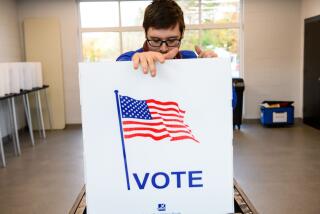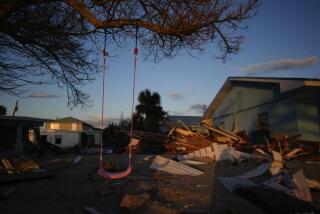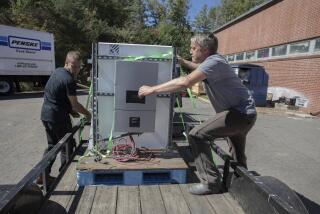Post-Sandy misery: Power out, toilets clogged, temperatures falling
NEW YORK -- Days after Sandy hit, metropolitan New York and the New Jersey coast continued their push to repair and rebuild amid rising tensions about the lack of electricity, the dearth of gasoline, the cold weather on the way and the frustrations over how long it takes to simply get around.
Millions of people in New York and New Jersey remained without power in a world where everything from elevators to refrigerators runs on electricity. Gasoline for cars and generators was in short supply and long waits continued at the few open gas stations.
There is growing controversy over whether city resources and personnel should be diverted to hold the annual New York City marathon, designed to be a joyful celebration by runners, tourists and spectators through the cityâs five boroughs.
âAll this storm stuff is just driving me crazy,â bartender Lindsay Benjamin said. One day she had to walk two hours from her unscathed home in Queens to get to work in midtown Manhattan.
âThe vibe is very nervous,â she said. âA lot of people are temperamental.â
PHOTOS: Images of the super storm
The national death toll from the super storm climbed above 90 and is likely to grow as the ongoing cleanup revealed the grim reality of destruction wrought by the record tidal surges and winds.
Residents in many hard-hit areas of New Jersey and New York -- regions already known for edginess -- were growing edgier as the early adrenaline-filled days of survival turned to the fatigue of grappling with the long recovery ahead.
From Farmingdale east on Long Island, to Westchester north of the Bronx, to northern New Jersey across the Hudson River and throughout the New York City itself, commuters queued up in hours-long lines at gas stations, and in some cases police responded to keep the peace.
AAA estimated that 60% that of the stations in New Jersey were closed, as were 70% of the stations on Long Island. The Department of Energy reported that 13 of the regionâs 33 fuel terminals are closed because of the storm. Sections of two major pipelines that serve the area are also down.
VIDEOS: East Coast hit by deadly storm
More than 1.7 million customers remained without power in New Jersey -- down from 2.7 million, but still large enough to breed frustration. Nationally, about 4 million customers are still without power -â down from a peak of about 8.5 million.
In Manhattan, the lack of electricity formed a tangible barrier. With promises of full restoration soon, at least 570,000 customers remained without electricity, down from 900,000 earlier this week.
New York Gov. Andrew Cuomo said he had talked to utilities and was hopeful that Con Edison could repower Manhattan as soon as Friday. He also warned the utilities that the state will continue monitor the cleanup and planned to âhold them accountable,â he said at a briefing.
He also said the state will create a $100-million fund to help with reconstruction.
INTERACTIVE: Before and after Hurricane Sandy
South of Manhattanâs 34th Street, an area that includes many commercial and residential high-rises, people were dealing with the miseries of clogged toilets, exhausting walks up flights of stairs and a lack of water for bathing and drinking.
Recharging cellphones and computers often involve a trek uptown. Those north of the divide were slowly coming back to normal. But garbage remained uncollected in many areas and foot power was still the most reliable mode of transportation.
The Pentagon deployed about 300 Marines and sailors and 17 planeloads of power equipment in an expanding relief effort. The National Guard helped distribute more than 290,000 meals and almost 523,000 bottles of water. An additional 1.5 million meals were en route, the Defense Department said.
Temperatures were expected to drop across the region into the 40-degree range during the day and lower at night, creating worries about how to heat homes where power is in short supply. There were also complaints that despite resupply efforts, aid is not being distributed fairly to all places, especially Staten Island, where at least 19 people died.
âWe have hundreds of people in shelters,â James Molinaro, the Staten Island borough president, said at a news conference. âMany of them, when the shelters close, have nowhere to go because their homes are destroyed. These are not homeless people. Theyâre homeless now.â
Residents were more vocal, telling CBS News that their community was being ignored -- a frequent complaint from the outermost of the outer boroughs. âThough people donât talk about Staten Island much, people are here, a lot of people are hurting, so itâs upsetting,â Natvel Pritchard said.
Homeland Security Secretary Janet Napolitano and Federal Emergency Management Agency Deputy Administrator Richard Serino planned to tour the island on Friday.
Especially galling to some is the marathon, scheduled for Sunday. Mayor Michael Bloomberg has said the 26.2-mile race, which begins in Staten Island and winds its way through the city, will go on.
âWhat we have here is terrible, a disaster,â Molinaro said at his news conference this week. âIf they want to race, let them race with themselves. This is no time for a parade. A marathon is a parade.â
Resident Nicole Malliotakis echoed that sentiment to reporters, telling CBS: âWe are far from fine and the fact that the mayor wants to have a marathon this weekend when we have people who lost either their lives or lost their entire house. ... I mean, itâs unbelievable to me.â
ALSO:
New York City public transportation free through Friday
After super storm Sandy, no hot showers but also no crime
Officials: Amid Sandy devastation, New Jersey needs more help
More to Read
Sign up for Essential California
The most important California stories and recommendations in your inbox every morning.
You may occasionally receive promotional content from the Los Angeles Times.











